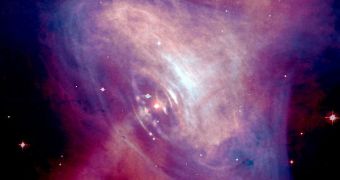In 2006, over the course of 120 days, scientists using the Hubble Space Telescope observed the most peculiar object they had ever seen. A mystery flash occurred in the observer's sight, and gradually began to increase in intensity. After reaching peak light, it gradually began to disappear, and was totally gone within three months of first making itself visible. Explanations for this event ranged from the normal (a glitch in the telescope's lenses or a spec of dust) to the paranormal (an alien spacecraft). Now, an astrophysicist at the University of Warwick believes he may have found the answer to the mystery.
Boris Gansicke, the leader of a research team at the university, believes that the luminous event may have been the trace of an exploding carbon-rich star, a very peculiar class of stellar objects, and a very rare one at that. The object, named SCP 06F6, was very puzzling to the initial team because the experts couldn't assess its distance from the Earth. In other words, they couldn't say whether it appeared in the Milky Way, or several billion light-years away. In a study following their research, the team left the field describing the nature of the object blank.
After having analyzed the data from the study, the UK team believes that the object bears resemblance to a class of carbon-rich stars, which are known as carbon stars. Thus, the experts were able to conclude that the star must have been at least 2 billion light-years away, and that only its death and explosion could have caused such a massive change in its redshift that allowed for Hubble to pick it up. In other words, what the telescope saw in 2006 was the trace of this explosion.
“The lack of any obvious host galaxy for SCP 06F6 would imply either a very low black hole mass (if black holes do exist at the centers of dwarf irregular galaxies) or that the black hole has somehow been ejected from its host galaxy. While neither is impossible this does make the case for disruption by a black hole somewhat contrived. Several new telescopes are now being designed and built that will continuously monitor the entire sky for short guest appearances of new stars, and there is no doubt that SCP 06F6 will not remain alone in puzzling astronomers over the coming years,” Gansicke stated.

 14 DAY TRIAL //
14 DAY TRIAL //